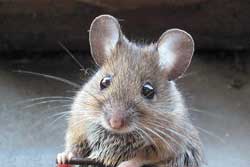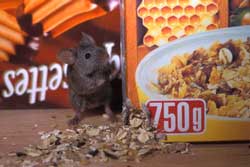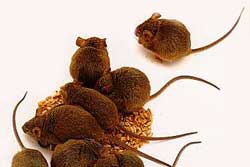Home → Pests → Other Critters → House Mouse
House Mouse—Mus musculus
The house mouse (Mus musculus) is considered one of the most troublesome and economically important rodents in the United States. In homes they feed on and damage food, contaminate food with droppings and urine, cause structural damage to building by gnawing and nest-building, including chewing on furniture and wiring. In addition, house mice can spread disease to humans and pets, including salmonellosis (food poisoning).

The adult house mouse is small and slender and about 1-2 inches long, excluding tail. It has large ears, pointed nose and small eyes. The tail is as long as the head and body combined. The fur color varies, but it is usually a light grey or brown, but could be darker shades.
Click on images to view full-size
Identification and Control Information
- Integrated Pest Management: Evict and Exile Mice From Your Home (PDF)—Cornell Cooperative Extension
- Prevention and Control of Wildlife Damage: House Mice (PDF)—Internet Center for Wildlife Damage Management
- House Mouse Prevention & Control—Illinois Department of Public Health
- Rodents—Centers for Disease Control and Prevention
Rodent Management Video Series – New York State IPM Program
- Rodent Management I: Why do I have Rodents? (YouTube)
- Rodent Management II: Signs of a Rodent Infestation (YouTube)
- Rodent Management III: Trap Selection and Placement (YouTube)
- Rodent Management IV: How to Keep Them Out (YouTube)
- Full Rodent Playlist (YouTube)
More Information
- Dealing with Nuisance Wildlife (PDF)—University of Maryland Cooperative Extension

